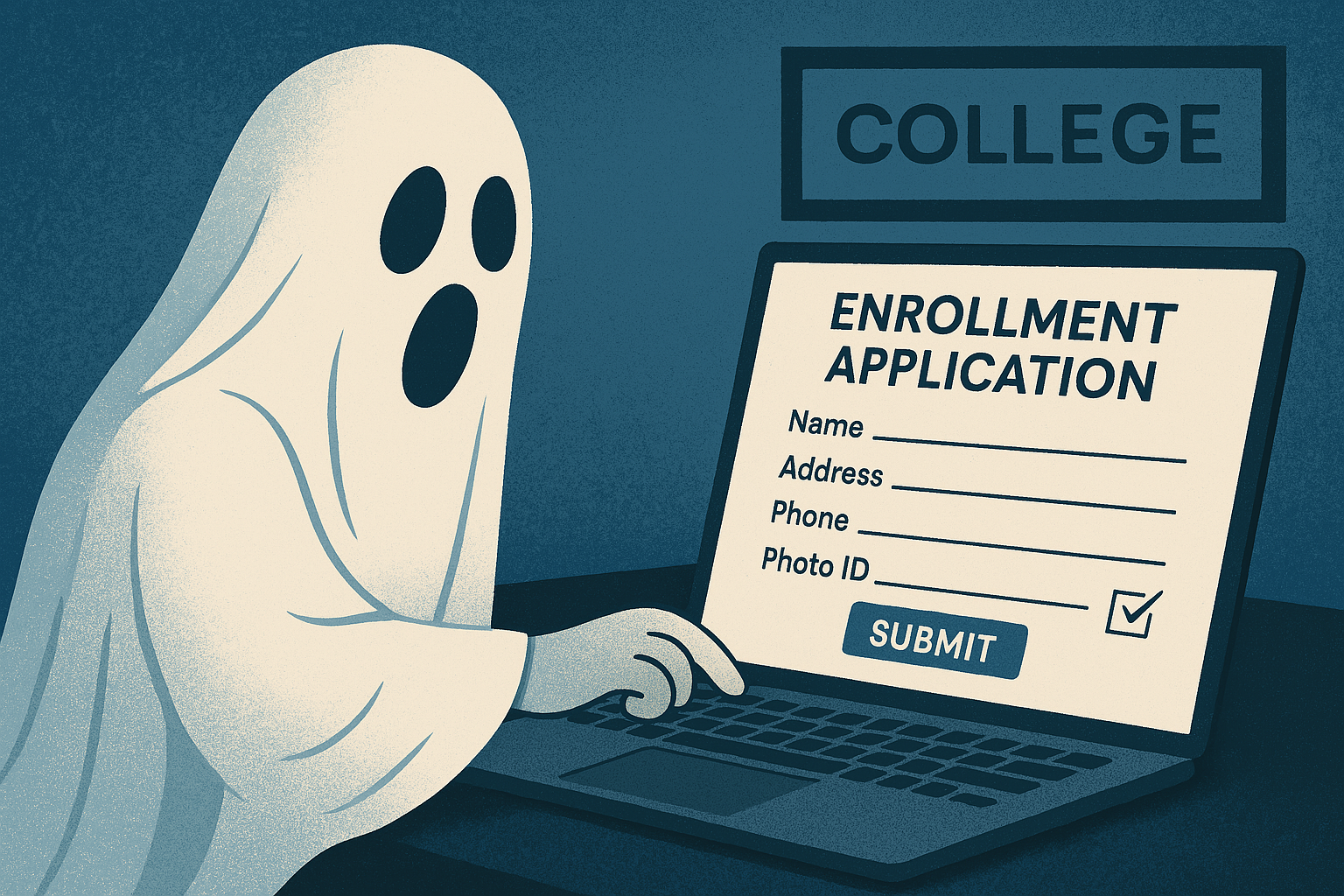
Identity fraud is increasingly being used to commit student loan fraud. Perpetrators—often called “ghost students” — typically pose as transfer students, enroll in classes, secure federal loan approvals, and then vanish once they receive the loan disbursements.
This fraud exploits gaps in the enrollment and financial aid process—especially in online and transfer systems.
Ghost students are not a new phenomenon in higher education. You may have heard them called “Pell Runners” or “Straw Students.” While this type of fraud has existed for years, it appears to have gained momentum during—and since—the pandemic.
Why? One major reason: the rise of online transfer processes. As more students transfer colleges remotely, identity verification procedures often fall short. Unlike in-person applications, online applications are less rigorously scrutinized to ensure the transfer enrollee’s identification actually belongs to them, making it easier for fraudsters to slip through using stolen or fabricated identities.
Criminal rings behind these ghostly scams quickly caught on. To scale their efforts, some fraudsters are also deploying bots (automated software applications) to complete transfer applications at volume.
During the pandemic, community and technical colleges across the country experienced a decline in enrollment. Those enrollment numbers have not yet returned to pre-pandemic levels, but many of these same schools have seen an increase in online transfers.
According to an article from the National Student Clearing House, college transfer enrollment grew for a third straight year. They go on to share that transfer enrollment has increased by 13.5 percent for community colleges from the fall of 2020.1
That’s good. Right?
Unfortunately, this increase has proven to be a double-edged sword for some schools. While it appeared as good news that enrollment had increased, the ghosts were already haunting the halls and absconding with federal loan money. Ghost students also inflated enrollment numbers, pushed real students onto class wait lists, and wasted university resources.
Real-world Examples of Ghost Student Fraud
These cases highlight actual ghost student scams uncovered in recent years:
- In March 2023, the U.S. Department of Justice reported that three women were arrested in California for allegedly using the identities of California prison inmates to enroll in a community college in Orange County, from which they applied and received nearly $1 million in federal student loans.2
- According to an article in the San Francisco Chronicle from July 2023, 20 percent of community college applications in California in the previous year were fraudulent, amounting to more than 460,000 fake applications.3
What’s Keeping This Scam Out of the Spotlight?
Searching for “ghost students” online revealed a few real-life stories of fraud and financial loss from various community and technical colleges across the county. However, there are far more ghost student scams occurring than are publicly documented.
While it may be uncomfortable for schools to admit they have been victims of such scams, and sharing these incidents can potentially add further harm to their reputation, it is crucial for institutions to actively communicate about the destructive impact of ghost student scams with their peers in higher education.
By sharing information, schools can foster industry-wide efforts to present a unified front against this type of fraud. This exchange of insights fosters the development of more effective prevention strategies. Increased awareness among staff and leadership enables teams to recognize, stop, and report suspicious activities more efficiently.
Often, the embarrassment of being a fraud victim leads schools to keep these incidents private, which can hinder collective learning and the development of collaborative mitigation techniques. By breaking down this stigma and promoting open communication, the academic community can strengthen its resilience and improve its long-term response to these types of scams. Sharing does not have to include all the ghostly ghastly details, but it should include lessons learned.
Steps to Prevent Ghost Student Fraud
Financial fraud involving U.S. Dept of Education funds or programs must be reported once a school becomes aware of it. But what can your school do to avoid becoming a victim of ghost student fraud?
Here are some actionable steps you can take to identify and thwart ghost student fraud:
- Actively monitor for fraud indicators, red flags, and unusual behavior, such as:
- Multiple students with the same name, mailing address, phone number, and class schedule
- Students with no transfer credits
- Students enrolling in low-engagement courses
- Students who fail to show up for class or withdraw immediately after receiving disbursements.
- Strengthen or implement ID Verification services, such as multi-factor identity checks for online and transfer applicants, including photo ID matching, document authentication, and live video verification if possible.
- Cross-check application data (like addresses, phone numbers, and academic records) for patterns linked to fraud rings or automation tools.
- Integrate software to detect and block bot-driven application activity, especially during peak enrollment periods.
- Monitor online applications to identify if the same IP address has been used multiple times.
- Educate admissions and financial aid teams to recognize signs of ghost student activity and respond quickly.
- If you receive calls from an actual identity theft victim, route the call to a supervisor or manager since it may be an indication that a ghost student is in your system.
- Utilize technology to track attendance and regularly review students who are not attending classes.
- Share information and fraud patterns with peer institutions and law enforcement to strengthen collective defenses.
By staying vigilant, strengthening verification processes, and fostering collaboration across departments, schools can protect themselves and their students from becoming targets. Combating this type of fraud requires not just awareness, but proactive, coordinated action.
Sources
1College Transfer Enrollment Grew by 4.4% in the Fall of 2024 – National Student Clearinghouse
2Three Women Indicted for Alleged Scheme that Used Prison Inmates’ Identities to Fraudulently Obtain Federal Student Loans – U.S. Attorney’s Office, Central District of California
3Thousands of ‘ghost students’ are applying to California colleges to steal financial aid. Here’s how – San Francisco Chronicle
The U.S. Department of Education has provided information for consumers and schools with suggestions on how to avoid being a victim, ways to spot fraud, and how to report it. Those links are included below.
Additional Resources
From the U.S. Department of Education, Office of the Inspector General

